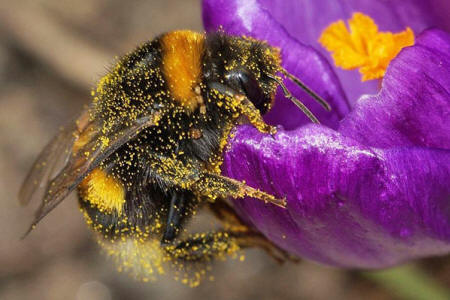|
Looking at ten bumblebee species in Colorado alpine meadows, two scientists found that removing a single bee species cut flower seed production by one-third. Pollinators worldwide are in major trouble as they are hit by habitat loss, pesticides, disease and other impacts.
In fact, the EU has recently banned several pesticides that have been linked to the global bee decline.
The study’s results, conducted in-the-field, contradicts past studies that have argued that plants would remain relatively unscathed in a world of fewer pollinators, so long as remaining pollinators picked up the slack.
However, those past studies have
depended solely on computer modeling; this new study is the first to
test that hypotheses in real world conditions.
A team of researchers then tracked the bees as they interacted with a flower called larkspurs.
A bumblebee (Bombus terrestris) covered in pollen.
But why would removing one bee species out of ten have such an outsized impact on plant production?
The key is in a pollinator’s fidelity to a specific plant species: pollination won’t occur unless a bee brings pollen from the same species.
However, the researchers found that by removing a single bee species, it upset the other bee’s fidelity.
In control plots, 78 percent of bumblebees visited just one species of flower, leading to a much better pollination success rate. However, in the plots where a species was removed, only 66 percent of the bees were faithful to one flower.
By removing a competitor the bees were more likely to visit a wider array of plant species.
The knock-off effect? Seed production
dropped by 32 percent for lackspur flowers, an impact the scientists
describe as "decreased ecosystem function."
The study also provide another example of the importance of biodiversity altogether
Scientists have been warning for decades that the world is likely entering a new age of mass extinction with untold consequences.
In recent years, pollinators have become in particular trouble. Over the last decade, bees have suffered from what has become known as Colony Collapse Disorder (CCD).
Although a number of factors have likely played a role - including disease and loss of habitat - a flood of new research has pointed to pesticide-use as a key factor to the decline.
Many butterfly species are also in
decline - such as
monarch butterflies
- while some species have vanished altogether. Despite their
ecological importance, pollinators are often given less conservation
and media attention than bigger, more "charismatic" endangered
species.
|

